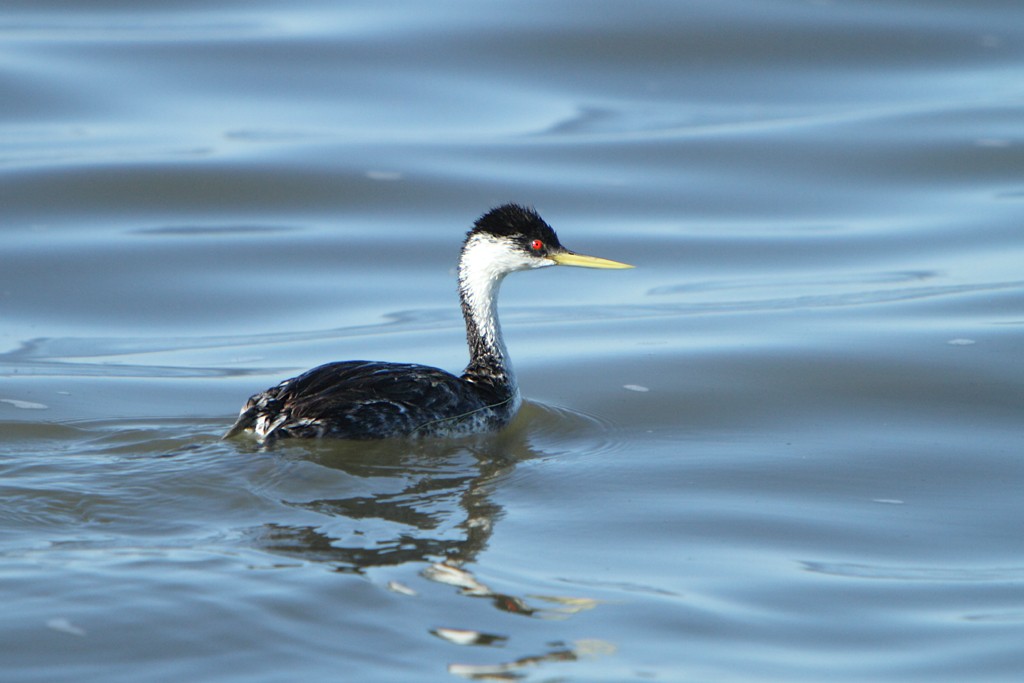Western Grebe
A species of North American Long-necked Grebes Scientific name : Aechmophorus occidentalis Genus : North American Long-necked Grebes
Western Grebe, A species of North American Long-necked Grebes
Botanical name: Aechmophorus occidentalis
Genus: North American Long-necked Grebes
Content
Description People often ask General Info
Description
The western grebe is the largest North American grebe. It is 55–75 cm (22–30 in) long, weighs 795–2,000 g (1.753–4.409 lb) and measures 79–102 cm (31–40 in) across the wings. It is black-and-white, with a long, slender, swan-like neck and red eyes. It is easily confused with Clark's grebe, which shares similar features, body size, behavior and habitat, and hybrids are known. Western grebes nest in colonies on lakes that are mixed with marsh vegetation and open water. Western Grebe nests are made of plant debris and sodden materials, and the nest-building begins roughly around late April through June. The construction is done by both sexes and is continued on throughout laying and incubation. This species of waterbirds is widespread in western North America, so there is no specific place of abundance. Its subspecies, Clark's grebe generally populate more of the southern part of North America Other differences are whiter flanks and paler gray backs when comparing A.o.clarkii to A.o.occidentalis. The western grebe has black around the eyes and a straight greenish-yellow bill whereas the Clark's grebe has white around the eyes and an up-turned bright yellow bill. The downy young of Western are grey; Clark's downy young are white. 
Size
56-74 cm (22-29 in)
Colors
Black
White
Life Expectancy
14 years
Nest Placement
Floating
Clutch Size
2 - 3 eggs
Incubation Period
1 brood
Number of Broods
24 days
Feeding Habits
Western Grebe primarily feeds on fish, supplemented by salamanders, crustaceans, worms, insects, and larvae. They dive, swim with mostly closed wings, and capture prey by jabbing or grasping with their bills. Prey is sometimes taken from the lake bottom and is either swallowed underwater or at the surface.
Habitat
Western Grebe predominantly inhabits large freshwater lakes and marshy environments lined with dense vegetation such as reeds and rushes. These birds show a preference for locations at low altitudes with temperate climates. During the breeding season, they may form colonies, some comprising hundreds of pairs. Post-breeding, many western Grebe transition to molting sites on lakes before migrating—now flight-capable—to coastal areas, including shores, bays, and estuaries. A minority remain inland, residing on rivers and lakes during winter.
Nest Behavior
Western Grebe pairs build their nests together, with males supplying larger material and females using wet algae for binding. The species exhibits attentive parental care throughout nesting.
Nest Characteristics
Western Grebe constructs its nest near water in emergent vegetation like rushes or reeds. The nest is a mound with a central depression, made from aquatic plants and anchored to substrates, measuring 2–3 feet across.
Dite type
Piscivorous
People often ask
General Info
Feeding Habits
Bird food type
Sounds
Call
Recording location: United States
Call
Recording location: United States
Behavior
Throughout the day, western Grebe exhibit a suite of distinct behaviors well-adapted to their aquatic environment. These birds are adept swimmers, employing their lobed feet to navigate waters but are infrequently observed flying due to nocturnal migration habits. Western Grebe are notably clumsy on land due to their awkward leg positioning and display a clear preference for remaining afloat. Their daily activities are interwoven with their habitat, as they forage, court, and raise their young within the water. The breed's courtship rituals are particularly emblematic, displaying an intricate series of behaviors known as 'ceremonies.' The 'rushing ceremony' and 'weed ceremony' are prime examples of western Grebe's exceptional courtship displays, involving synchronized movements and rituals between pairs, which culminate in visually striking sequences. With roles distinctly allocated between sexes during nesting, both male and female western Grebe contribute actively to territory defense and rearing of offspring, commonly observed with hatchlings securely perched atop parental backs.
Species Status
Not globally threatened.
